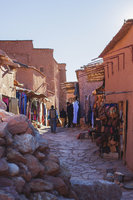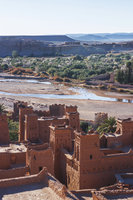Morocco, Ait Ben Haddou – Ksar in the Ounila Valley
Published: 30.7.2022
Undoubtedly, Morocco is one of the most diverse countries, mainly because of its size. The nature of the landscape changes significantly with kilometers traveled, so in a few days in one country you can get from the Atlantic coast through the Atlas Mountains to the vast palms, gorges and also the desert.
It is best to take the route from the seaside Essaouira (formerly Mogador) via Marrakesh, after which the altitude kilometers in the Atlas Mountains are a breeze. From Marrakesh, the old caravan route leads to the desert, and just after that it is best to go. However, the bad roads swept away by spur wheels and horse-drawn carriages (although they can be met in Morocco) do not wait as soon as you leave the mountain serpentines, waiting for you hundreds of kilometers of driving with absolutely straight plains over repaired roads.

And on these plains, specifically in the Ounila Valley, which falls into the Ouarzazate province, is the pearl of the right Morocco, ksar (fortified village) Ait Ben Haddou. It is the most important and best preserved example of traditional Moroccan clay architecture, the present form dates back to the 17th century AD, but the building techniques used are essentially older. It is unique because of the state it is in. Unlike other ksars and kasbahs (family fortified settlements) in the area, it has been preserved to this day without any significant damage.



Ait Ben Haddou is situated on the hillside of a lone rocky hill, lined with rich palmeria and lazy river flows. Not only are clay buildings, despite their appearance with the surrounding landscape, the most spectacular point of the valley, they also provide protection from the insistent African sun and, in the past, the determined attackers, for whom the orientation inside the fort had to be a superhuman task, thanks to its southward orientation.
Nowadays, however, the locals have moved across the bridge to the other bank of the river bed, where they have built more modern houses equipped with air conditioning and security systems. Only four families are now living in the fort, but in the past they were able to accommodate up to several thousand people.

In 1987, Ksar was legitimately listed as a UNESCO World Heritage site. Ait Ben Haddou has greatly helped filmmakers, for whom Morocco has long been visually appealing and, above all, a cheap location. Scenes from many films (such as Gladiator, Mummy, or Kingdom of Heaven) were filmed right in the fortress and its surroundings, but most of all, local tourism was influenced by the appearance of the local ksara as slaver's fortress Yunkai in the popular Game of Thrones series.
GPS: 31°02'49.8"N 7°07'53.0"W
Text and photos: Barbara Nováková

Related Articles
Published: 3.5.2023
The original Arab name of the Algerian capital means Islands. It refers to four islands by the Algerian shore, which later became part of mainland.
Published: 6.8.2022
raveling to see movie backdrop is more popular every year, so it's no wonder that the Ouarzazate Moroccan Valley is a sought-after and, most of all, a cheap destination for movie enthusiasts from around the world. Everyone is eager to see and touch the scenery that has played a major role in many series and movies. In the valley you can see real shooting places, such as the historic Kasbah Ait Ben Haddou. Above all, there are large Atlas studios built on the dusty plains of the eastern foothills of the Atlas Mountains.
Published: 13.8.2022
Ourika Valley is about 30 km from Marrakesh, literally on the high Atlas. A river of the same name flows through it, creating a narrow valley between the high mountains and a narrow valley on both banks.
Published: 21.12.2018
You have already had a chance to see Morocco, specifically Rabat, with us. Today, however, we dive deep into this interesting city and escape the winter that prevails with us.
Published: 20.8.2022
If you want to move to a quieter but equally interesting area of Marrakesh for a moment, the coastal city of Essaouira (formerly known as Mogador) is the right choice. Located on the west coast of Morocco, this pleasant city is soaked in the Atlantic Ocean and the way to it is through endless argan fields.
Published: 27.8.2022
If you are going to the desert while traveling across Morocco, do not miss the relatively large provincial town of Tinghir and its annexed Palmeria on your way to Merzouga. It is actually an oasis, the last nice place to live before entering the plains leading into the desert. There are over 40,000 inhabitants in the city, most of whom are Berber ethnic. It is one of the poorest regions in the country and you will probably encounter begging children who are accustomed to regular income from the pockets of tourists while staying in the area.
Published: 3.9.2022
In relation to Morocco, everyone will surely recall, besides local colored ceramics, clay architecture, tajines (long swaths) and long caftans, the orange-colored Moroccan part of the Sahara. It is an element so typical for this country that it is almost unbelievable that desert dunes only spread to a small percentage of otherwise vast land. The largest and most famous dune is undoubtedly Erg Chebbi.
Published: 10.4.2015
We travel to the north from Senegal to northwestern part of African continent. Our destination is Morocco, the country which covers around half-a-million square kilometers and where live 33 million people.
Published: 16.7.2022
Imlil is a relatively small mountain village located in the western part of the Atlas Mountains, roughly in the central part of Morocco. In fact, it is not so interesting in itself, but still welcomes thousands of visitors every year. You ask why? This is the place where alpine tourism enthusiasts go to the highest mountain in North Africa, Jebel Toubkal.
Published: 9.7.2022
Before we go together to explore other Casablanca monuments, we will introduce you to urban culture.
Published: 2.7.2022
The sun barely rises above the horizon, and Casablanca is awake. Red taxi cabs drive in the streets lined with modern buildings. You feel an incredible amount of energy around you, which, of course, overflows with you. It just lives in Casablanca.
Published: 23.1.2021
This time we will head to the north of Tunisia, where we will be greeted by architecture with Moorish elements, friendly inhabitants and, most importantly, infinitely long beaches. But we plan to explore Tunisia a little more than just from a beach chair.
Published: 28.12.2018
In the previous article on Rabat we told you about the history and architectural heritage of this city. Today we will be interested in local culture.
Published: 21.10.2017
When traveling from Fez, we travel across Meknen plain dubbed the Garden of Morocco. All you can think of grow here – melons, bananas, oranges, lemons, almonds, and grain.
Published: 28.10.2017
In the second part of Fez, we take a look at the Blue Gate which is green from the other side for it is the color of Islam and blue is the color of Fez. There is a lots of vegetables, nuts, dates, and chickens around.
Published: 4.11.2017
We spend this day in Marakesh. In the morning, we enter Agdal, gardens founded by the Berber dynasty of Almohad in the 12th century. They constructed here a network of water reservoirs and canals. This is the most advanced water reservoir in Maghreb. Thanks to this reservoir, there is a large olive tree garden around it. We approach the large reservoir filled with water. In the background, we see the High Atlas with its snow caped mountains. High palmas around us only add to this incredible place.
Related Photogallery
Would you love some romantic adventure? Visit Morocco with beautiful beaches, ancient Atlas mount...


















![]() Information and warnings on travelling abroad is to be found HERE.
Information and warnings on travelling abroad is to be found HERE.




























